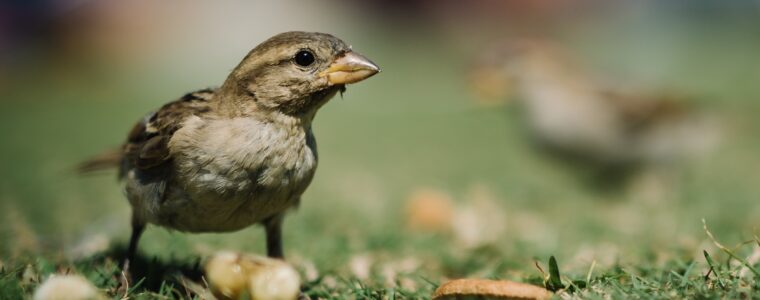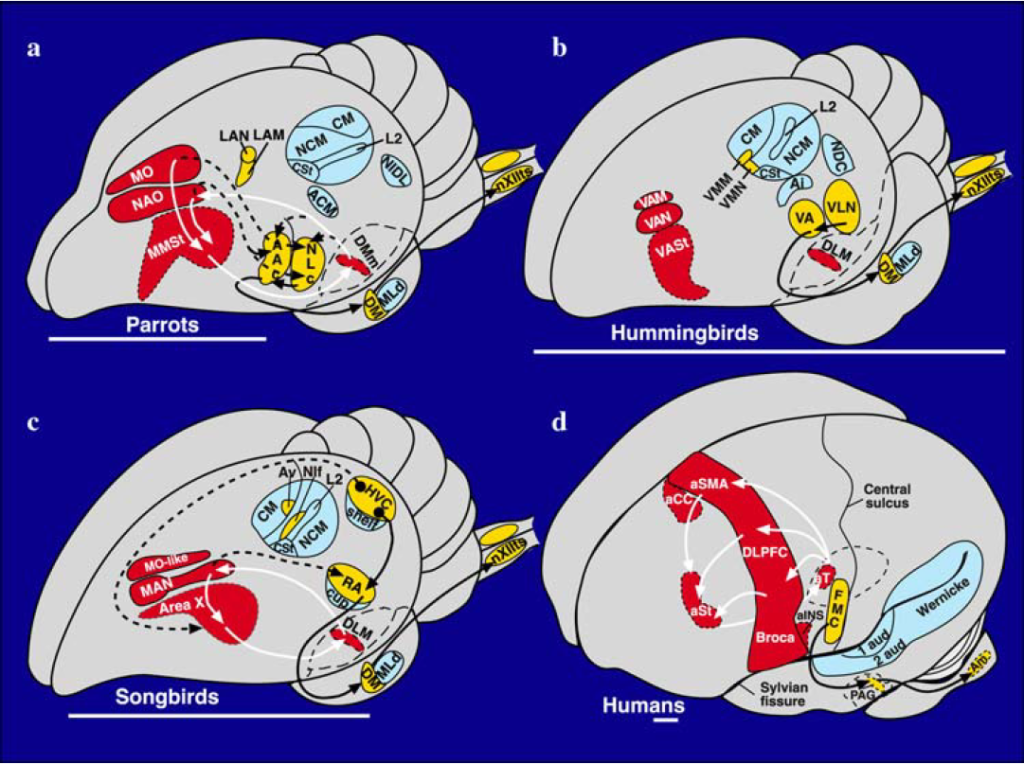
Modern birds are descendants of probably three different dinosaur lineages. Those three lineages have evolved into 47 different orders as described by the International Ornithological Congress (IOC; Gill et al., 2021) although as genetic testing improves and increases in simplicity, this number may change. Of those 47 orders, only three contain bird species that show active learning of song (Figure 1). All bird species have innate calls that are described as a cheep, peep, seep, squawk, or some chattering vocalization. These calls signal specific information such as “Danger” or “I’m here, where are you?” or “Stay away,” and especially by the young, “Feed me”, all of which are signals of a non-sexual function. Calls are not musical and they possess a relatively simple acoustic structure.
Songs, on the other hand, are made of numerous notes, some of which might be repeated as phrases. Songs are musical and complex, but most importantly, for most species, songs are learned from parents and neighbors of the same species because songs are used as mating attractants. Stick your head out the door at sunrise and you will hear a cacophony of different songs. Each bird is trying to attract a mate of the same species.
We believe songbirds and humans do not have a common ancestor possessing language learning, but about 50 years ago, Fernando Nottobohn of the Rockefeller University wrote an influential paper in Science magazine in which he associated song learning by song birds with language learning by humans. This association means songbirds and humans must have independently evolved their “language,” which makes language learning itself a particularly interesting skill. That is, as far as we know today, birds and humans do not have a common ancestor with language learning. More interestingly, song learning and language learning have many features in common. Consequently, these skills are ripe for comparative studies.
Many researchers study human language learning and that topic specifically, I am not going to discuss here. Not only did song birds and humans evolve independent language learning skills, but apparently, if one looks at the phylogeny of all birds (Figure 1), three separate and distant groups of birds also possess song learning skills. Their positions in the phylogenetic tree of birds suggest they too may have independently learned to sing. The three song learning bird orders are Passeriformes (songbirds), Psittaciformes (parrots), and Trochiliformes (hummingbirds) as indicated in red in Figure 1.

As you can see, the first two are related in that they have a common, ancient ancestor, but the hummingbirds are distant from that ancestor. Thus, comparative biologists would interpret this as hummingbirds having developed their song skill independently from any other avian order. The songbirds and parrots may also have independently learned song for individuals in their nearest neighbor’s orders do not learn songs. Research in the last 20 years has revealed a unique pattern in which the song circuits in all three bird orders have remarkable similarities to the human language circuit despite the difference in how sounds are made. Birds make sounds with a syrinx which is located at the bottom of the Eustacean tube (Figure 2-left) and is controlled by a brain area called the Hypoglossal Nucleus via the Hypoglossal cranial nerve (or cranial nerve 12). We humans make sounds with our larynx. The larynx is located at the top of the Eustacean tube (Figure 2-right) and its muscles are controlled by the ‘laryngeal branch’ of the Vagus Nerve (or cranial nerve 10). Again, these differences in location and control suggest independent evolution of the “song/language” circuits.

The Circuit
Vocalization is due to shaped airflow across the larynx (humans) or syrinx (birds), which means one part of the vocal circuit is due to breathing outward. The second part of the circuit is due to learning the phonetics of the song/language, which involves the circuit from the ear to the forebrain. Why the forebrain? Because individuals (birds and humans) construct language from individually learned sounds, word meanings, and syntax, or how the song/words are put together. We know those are tasks performed in the forebrain. Consequently, for a vocal learning circuit, we need to connect the forebrain with breathing. A researcher at Rockefeller University, Erich Jarvis, has done exactly that. In a marvelous study published in the Journal of Ornithology (Jarvis, 2007), he identified corresponding circuits in songbirds, parrots, and hummingbirds, and compared them to the human language circuit. Figure 3 illustrates some of his fundamental insights, and also problems.

The color coding of this diagram (Figure 3) simplifies its technical difficulties. Starting with the lower right (Figure 3d), the human brain diagram, we find yellow regions with the black arrows indicating a potential posterior vocal pathway in which vocal control signals are generated in and exit the forebrain to the vocal apparatus (the larynx in this case). The red regions with white arrows indicate an “anterior vocal pathway” or one in which the structure, the content, and the mechanical output of a vocalization are generated. The light blue regions are the classic auditory cortex and Wernicke’s area, famous for encoding word meaning. The important point is that the three colored regions represent different but intersecting networks or functional circuits.
If we closely look at the analogous networks in parrots (upper left; Figure 3a), hummingbirds (upper right; Figure 3b) and songbirds (lower left; Figure 3c), we see three circuits representing the same three as in human although not exactly identical. The differences lay with the names and the approximate size of each region, but the networks are conceptually similar. As in any scientific issue, the entirety of all three avian circuits are not completely known, but a sufficient amount is known to say that the three orders of birds have similar components and similar networks. (Names of corresponding areas in the different brains are not identical, but that is due to an historical artifact, which is yet another topic for another time.) From Figure 1, we would not be surprised that songbirds and parrots share similarities but to include hummingbirds is very surprising due to their evolutionary distance.
I personally believe that the similarity between the three bird orders that learn songs means that a common ancestral brain framework must have been in existence to all three and as it evolved, the brain network solved similar problems of vocalization in the social milieu of all three. So why don’t species of the other 44 orders sing? I suspect there are as many as 44 different reasons why they did not develop song learning. This question is unanswerable at the present time, but here are two possibilities
The first depends upon social organization and mating behavior. Perhaps those other 44 orders require only an answer to the behavior, “Let’s mate.” Perhaps choosing a mate is not particularly significant other that a mate be of the opposite sex and of the same species. That approach might answer for some of the 44 other bird orders, but not all, for song attraction by a female of those three orders (Passeriformes, Psittaciformes, and Trochiliformes) for a mating partner is an active selection. That answer may also suffice for primates and as an explanation for the circuitry similarities.
The other possibility is more exciting. Perhaps language learning requires certain specific processes. These processes may be independent of the specifics of a particular language. We know when learning language, human babies eliminate some potential sounds to develop sounds used in the language they hear. They practice the sounds of their eventual language as babble. Songbirds do the same. They take an initial period of time to practice and shape the sounds they heard in the egg and nest to form their songs. These sounds are eventually crystallized into adult songs when ready to mate. The process is similar in both cases. This approach to the potential for learning suggests that a nascent circuit may exist in every vertebrate brain, but is exposed and developed in a few due to still unknown circumstances.
Written by Dr. William Saidel, FCW guest writer
Dr. William (Bill) Saidel is a neurobiologist and Professor Emeritus at Rutgers University—Camden. You can learn more about his research interests here: https://saidel.camden.rutgers.edu/
References:
- Besteiros, M. (2020, May 19). Why Can Parrots Talk Like Humans? Animal Wised. https://www.animalwised.com/why-can-parrots-talk-like-humans-3470.html
- Gill, F., Donsker, D., & Rasmussen, P. (Eds.). (2021). IOC World Bird List (v11.1). https://www.worldbirdnames.org/new/
- Jarvis, E. D. (2007). Neural systems for vocal learning in birds and humans: A synopsis. Journal of Ornithology, 148, 35-44. https://doi.org/10.1007/s10336-007-0243-0 Petkov, C. I. & Jarvis, E. D. (2012). Birds, primates, and spoken language origins: Behavioral phenotypes and neurobiological substrates. Frontiers in Evolutionary Neuroscience, 4, 1-12. https://doi.org/10.3389/fnevo.2012.00012
